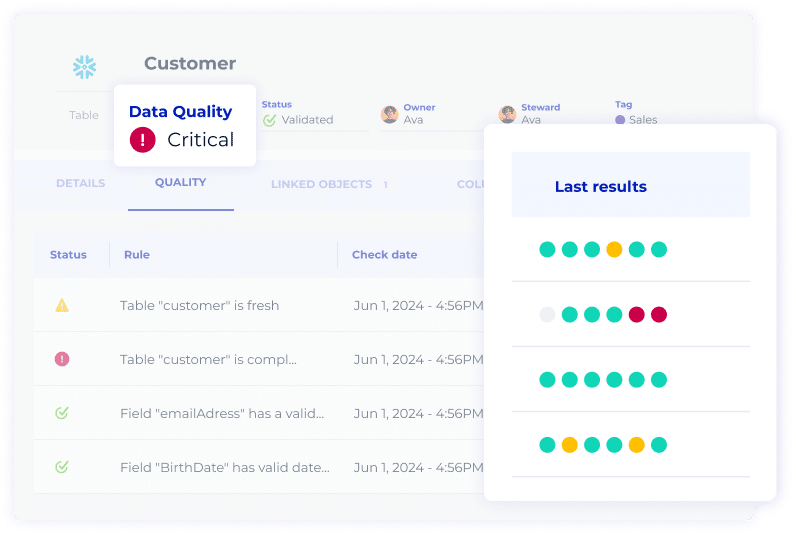Data governance is a critical component of any organization's data management strategy. It provides a structured framework for establishing policies, procedures, and controls to ensure data quality, security, compliance, and accessibility.
A successful data governance framework comprises several key pillars forming the foundation for effective practices. In this article, we will explore eight essential pillars of a data governance framework, so keep reading to expand your knowledge and learn something interesting.
1. Data governance strategy & objectives
The first pillar of a successful data governance framework is a clear data governance strategy and well-defined objectives. Organizations must establish a data governance vision, align it with their overall business strategy, and define specific objectives that the data governance program aims to achieve.
This includes outlining the desired outcomes, such as improving data quality, enhancing compliance, and enabling data-driven decision-making. The data governance strategy provides a roadmap for implementing data governance practices and ensures alignment with the organization's goals.
2. Data governance roles & responsibilities
The second pillar focuses on defining clear data governance roles and responsibilities. It is essential to identify individuals responsible for data governance activities, such as data stewards, data owners, and data governance committees.
These roles should clearly define responsibilities, authority, and accountability for data-related decisions and actions. Organizations assign specific roles and responsibilities to ensure that data governance practices are effectively implemented, monitored, and maintained. A clear delineation of roles helps foster a culture of data accountability and ownership within the organization.
3. Data governance policies & procedures
Data governance policies and procedures form another crucial pillar of a successful data governance framework. These policies define the rules, standards, and guidelines for managing data across the organization.
Policies may include data classification, data quality requirements, data privacy, data security, and data retention. Procedures outline the step-by-step processes for implementing data governance practices, such as data profiling, cleansing, and access controls.
Well-defined policies and procedures ensure consistency, clarity, and adherence to data governance practices throughout the organization.
4. Data quality management
Data quality management plays a pivotal role as one of the foundational pillars within a robust data governance framework. It encompasses a range of processes and controls to guarantee the accuracy, completeness, consistency, and timeliness of data. These initiatives include data profiling to analyze data characteristics, data cleansing to rectify errors and inconsistencies, data validation to ensure adherence to predefined quality standards, and data monitoring to assess data integrity continuously.
Metadata management serves as another pillar of a successful data governance framework.
Metadata provides contextual information about the organization's data, such as data definitions, data lineage, data relationships, and data transformations. Effective metadata management ensures that users can easily discover, understand, and utilize data assets.
It enables data governance practices such as data lineage tracking, impact analysis, and data discovery. By implementing robust metadata management practices, organizations can maximize the value of their data assets and facilitate data governance processes.
Data quality monitoring
Building success together on a strong foundation of high-quality data
At DataGalaxy, we champion data quality, emphasizing accuracy, reliability, and consistency. By pulling data health signals into DataGalaxy, we strengthen our commitment to data integrity and operational excellence, ensuring businesses make informed decisions with confidence.
5. Data security & privacy
Data security and privacy are fundamental pillars of a successful data governance framework. Organizations must prioritize protecting sensitive information, prevent unauthorized access, and ensure compliance with data protection regulations.
Robust data security measures, such as access controls, encryption, and authentication mechanisms, should be implemented to safeguard data assets from external threats and breaches. In addition to data security, ensuring data privacy is equally crucial.
Organizations must establish policies and procedures to handle personal and sensitive data in accordance with applicable privacy laws and regulations. This includes obtaining proper consent, implementing data anonymization techniques, and establishing data retention and disposal practices.
By maintaining strong data security and privacy measures, organizations build trust with customers, partners, and stakeholders, fostering a reputation of reliability and responsibility. Implementing data security and privacy controls within the data governance framework demonstrates a commitment to protecting data assets and complying with legal and ethical obligations.
It allows organizations to mitigate risks associated with data breaches, avoid reputational damage, and maintain the integrity and trustworthiness of their data.
6. Data governance communication & training
Effective communication and training are essential pillars of a successful data governance framework. Clear and ongoing communication about data governance initiatives ensures that all stakeholders understand the program's importance, benefits, and expectations.
This includes communicating data governance policies, procedures, and changes to relevant organizational personnel. Providing comprehensive training programs to educate employees about data governance principles, best practices, and their roles and responsibilities is crucial.
By fostering a culture of data governance through effective communication and training, organizations can enhance adoption, engagement, and compliance with data governance practices.
7. Data governance measurement & monitoring
Measurement and monitoring form another crucial pillar of a successful data governance framework. Establishing key performance indicators (KPIs) and metrics allows organizations to assess the effectiveness and impact of their data governance initiatives.
KPIs may include data quality scores, compliance levels, data access logs, and user satisfaction surveys. Regular monitoring of these metrics helps identify areas for improvement and track progress toward data governance goals.
By measuring and monitoring data governance practices, organizations can make informed decisions, drive continuous improvement, and ensure the ongoing success of their data governance framework.
8. Data governance maturity & continuous improvement
The pillar of data governance maturity and continuous improvement emphasizes the importance of evolving and maturing the data governance framework over time.
Data governance is not a one-time implementation but a continuous journey of improvement and refinement. Organizations should regularly assess their data governance maturity level, identify gaps, and develop a roadmap for continuous improvement. This involves staying updated with industry best practices, adapting to technological advancements, and aligning data governance practices with changing business needs.
By focusing on continuous improvement, organizations can enhance their data governance framework's effectiveness, agility, and value and ensure its long-term success.
Organizations can establish a solid foundation for effective data management, compliance, and data-driven decision-making by incorporating these eight pillars into a comprehensive data governance framework. Each pillar plays a crucial role in ensuring the success and sustainability of data governance initiatives, enabling organizations to harness the full potential of their data assets and drive business excellence.
Fueling smarter decisions for
200+ industry powerhouses.










